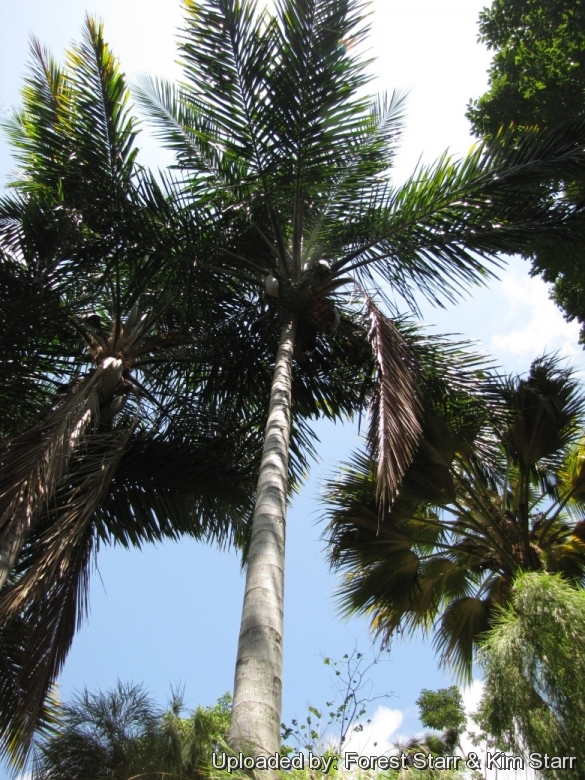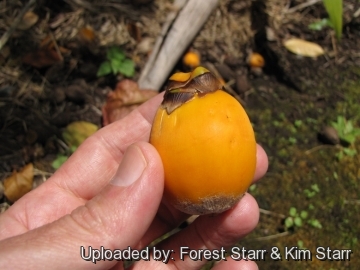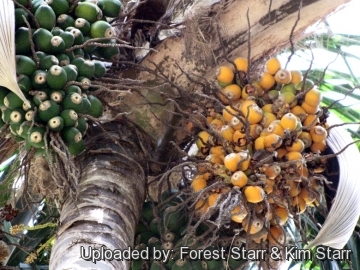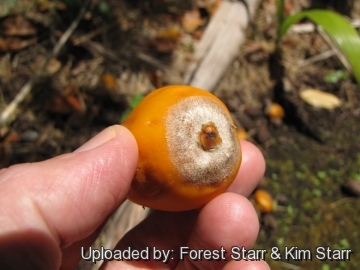




Your support is critical to our success.
Accepted Scientific Name: Syagrus amara (Jacq.) Mart.
Voy. Amer. Mer. 7(3): 132 (1847) A.D.Orb.

Habit at Iao Tropical Gardens of Maui, Maui, Hawaii (USA). May 22, 2012.
Origin and Habitat: Syagrus amara is a solitary palm which grows in the Lesser Antilles in Montserrat, Guadeloupe, Dominica, Martinique, and St. Lucia, making it the only Syagrus species not native to South America. It is grown in the West Indies and elsewhere in the tropics as an ornamental.
Altitude range: Below 300 m elevation
Habitat and Ecology: This stately tall palm typically grows in full sun in both dry and wet coastal habitats.
Synonyms:
- Syagrus amara (Jacq.) Mart.
- Cocos amara Jacq.
- Rhyticocos amara (Jacq.) Becc.
ENGLISH: Overtop palm, Moca palm, Rhiticocos Palm
FRENCH (Français): Palmier amer, Yattahou (Dominica), Coco nain (Dominica), Kokoyé (Dominica), Petit coco de bois (Guadeloupe), Petit coco (Martinique), Mocho (Montserrat)
Description: Related to and resembling the Coconut (Cocos), Syagrus amara is a majestic single-trunked monoecious palm with long slender stems to 20 metres tall. It is topped with a bushy head of beautiful shining dark green ascending pinnate-leaves. It is one of the tallest of the Syagrus and was previously placed in the genus Rhyticocos. The only comparable palm in the area is the coconut (Cocos nuciferaSN|24379]]SN|24379]]), which is easily separated by its leaning stem, lighter foliage with leaflets spreading in the same plane and larger fruits.
Stems: Slender, solitary, reaching in habitat an ultimate height of 15-20 m, ringed and markedly swollen at the base. Bole 10-20 cm diameter. In cultivation these palms grow much larger than in habitat and often forms stem with the typical flare at ground level. Above the flare the stem measures may reach 30 cm in diameter.
Leaves: 12-15, unarmed, large, pinnate and slightly feathery to 3 m long (up to 4 long in cultivation) quite erect and arching only slightly. Leaflets numerous 102-106 per side, stiff, shiny very dark green, rigid, with a strong midrib, irregularly arranged in clusters of 2-3 and spreading in different planes, but the leaf not markedly plumose. As a young palm, this one is quite ornamental in having long, wide un-split leaves (called strap leaves), that eventually split once the palm starts to grow a trunk.
Inflorescences: Emerging from the leaf crown, with about 50 flowering branches and both male flowers (to end) and female (to the base). The woody bract is spoon or boat-shaped.
Fruits: Hard-shelled, fairly large and closely resembling miniature Coconuts that hang in clusters just below the crown when ripe, ellipsoid, 5-7 cm long and 3.5 cm diameter, orange. Endosperm ruminate, much like a Beccariophoenix, with a central cavity.
Bibliography: Major references and further lectures
1) "Syagrus amara." rarepalmseeds.com , <http://www.rarepalmseeds.com> Web. 12 Sep. 2014.
2) Michael J. Balick, Hans T. Beck “Useful Palms of the World” Columbia University Press 1990
3) Andrew Henderson “Field Guide to the Palms of the Americas” Princeton University Press, 1997
4) Santiago Madriñán “Nikolaus Joseph Jacquin’s American Plants: Botanical Expedition to the Caribbean (1754–1759) and the Publication of the Selectarum Stirpium Americanarum Historia” BRILL, 28/Mar/2013
5) Jack Krempin “Palms & Cycads Around the World” Horwitz Grahame, 1990
6) Charlie Beck “GROWING Syagrus amara IN PALM BEACH COUNTY” <http://www.palmbeachpalmcycadsociety.com/palms/documents/Syagrusamara.pdf > Web. 12 Sep. 2014.
7) Wikipedia contributors. "Syagrus." Wikipedia, The Free Encyclopedia. Wikipedia, The Free Encyclopedia, 8 Sep. 2014. Web. 11 Sep. 2014.
8) Forest & Kim Starr Syagrus amara (Overtop palm, moca palm). Plants of Hawaii. <http://www.starrenvironmental.com>. Downloaded on 21 August 2014.
9) John Dransfield, Natalie W. Uhl “Genera Palmarum: the evolution and classification of palms” Kew Pub., 2008
10) Don Ellison, Anthony Ellison “Cultivated Palms Of The World” UNSW Press, 01/May/2001
11) Govaerts, R. & Dransfield, J. “World Checklist of Palms”. The Board of Trustees of the Royal Botanic Gardens, Kew. 2005.
12) Palmpedia contributors. "Syagrus amara" Palmpedia, PALM ENCYCLOPEDIA, <http://www.palmpedia.net> Downloaded on 26 Aug. 2014
13) Robert Lee Riffle, Paul Craft “An Encyclopedia of Cultivated Palms” Timber Press, Portland 2007
14) "Syagrus amara." PACSOA Palms and Cycads wiki , <http://www.pacsoa.org.au> Accessed on 28 Aug. 2014

Fruit at Iao Tropical Gardens of Maui, Maui, Hawaii (USA). May 22, 2012. (Syagrus amara) Photo by: Forest Starr & Kim Starr

Large fruit at Iao Tropical Gardens of Maui, Maui, Hawaii (USA). May 22, 2012. (Syagrus amara) Photo by: Forest Starr & Kim Starr

Fruit at Iao Tropical Gardens of Maui, Maui, Hawaii (USA). May 22, 2012. (Syagrus amara) Photo by: Forest Starr & Kim Starr

Maui, Maui, Hawaii (USA). May 22, 2012. (Syagrus amara) Photo by: Forest Starr & Kim Starr
Cultivation and Propagation: Syagrus amaraSN|28692]]SN|28692]] is a quite fast growing, frost, and drought tolerant with quite large orange fruits and the crown really looks like a Coconut. Therefore, it is desirable and a good collector palm. It is obviously more cold hardy than a Coconut. It is occasionally used in landscape around the world in tropical, subtropical and temperate regions due to its imposing attractiveness and hardiness. It is easy to grow in a wide variety of conditions. Both drought and frost resistant. People tend to discount the entire genus of Syagrus because of their familiarity with the common Queen Palm (Syagrus romanzoffianaSN|28692]]SN|24697]]). There are several species of Syagrus that are unusual and worth planting Syagrus amara is one of them.
Soil: It is most suited for acidic, well-drained soils comprising clay; loam; sand and shows severe mineral deficiencies on alkaline soil.
Fertilization: Need a perfect fertilizer diet including all micro nutrients and trace elements or a slow release fertilizer applied in spring and summer, or according to package directions. Micronutrient deficiencies are a serious problem on soil with a high pH. This disfigures the palm by stunting the young leaves and can kill it. To prevent this problems the palm requires regular preventive applications of manganese and/or iron to help keep the fronds green. If it doesn't get enough Potassium (K), the older leaves in well-drained soils take on a necrotic spotting. Necrosis of the leaflet margins, followed by leaflet tip necrosis will also become apparent. With regular fertilization they never shown any micronutrient deficiencies.
Water Requirements: It tolerates low levels of humidity and summer drought, though it prefers evenly moist but not consistently wet medium. When supplied with adequate moisture and fertilizer it is also fairly fast growing. This palm is very drought tolerant once established. Water young plants for healthy look and fastest growth. Periodic inundation does not harm this palm.
Light: Can take full sun from an early age, but it also does well in part shade with some direct sunlight when young.
Aerosol salt tolerance: It is slightly salt-tolerant and may be grown near the sea protected by dunes or building.
Wind resistance: It endures drying winds.
Hardiness: These palms are some of the hardier palms, tolerating light frosts for short periods, although it will require some protection if cold periods are longer than normal. USDA hardiness zones: (9B-)10 through 11.
Roots: Surface roots are usually not a problem.
Maintenance: The dead fronds are persistent and often require pruning to remove. As the old fronds die, these should be trimmed off and the leaf bases allowed to dry out, but is susceptible to Fusariam Wilt, a fungal disease that is spread by pruning with 'infected' shears/pruners. All those pruning multiple palms are urged to clean the instruments with bleach or something that kills the fungus. Fruit, twigs, or foliage cause significant litter, persistent at the base of the tree.
Uses: It is used in gardening and landscaping in many parts of the world though in sheltered areas it will survive short periods below freezing point. It is not suited to small gardens, due to its eventual large size. The huge bulk of Syagrus amaraSN|24697]]SN|28692]] dwarfs most houses. This palm is very good for adding a tropical feel and used along boulevards, on campuses, lawns and in parks and grouped in trios to form focal points in cityscapes. It is recommended for buffer strips around parking lots or for median strip plantings in the highway. Seedlings are quite slow, but speed up considerably once they start to trunk. Small specimens are inexpensive and readily available and look great in pots on the patio, near the pool, or in pairs flanking entryways. And thanks to its drought resistance and durability to heat it can thrive in harsh urban conditions. It is not a good indoor palm and gets "top heavy" as a container plant.
Traditional uses: The young leaves were plaited together for thatch. The edible palm heart of Syagrus amaraSN|28692]]SN|28692]] is not eaten in the region though this species was tapped as a source for juice to make wine. The fruits were formerly used to make a fermented drink and the fairly bitter kernels are often eaten by the children. Oil from the kernels was mixed with red pigments from Bixa orellana seeds to make body paints.
Pest and disease: Long-term health usually it is not affected by pests even if scale my be a problems. Ganoderma butt rot caused by Ganoderma zonatum can kill it. There is no control for butt rot, only prevention. This palm is not affected by lethal yellowing disease.
Propagation: It is exclusively propagated by seed. Seed is very easy to germinate, and small seedlings carpet the ground under mature specimens.
| Your Actions | |
|---|---|
| Back to Rhyticocos index | |
| Back to Arecaceae index | |
 |
Back to Palms And Cycads Encyclopedia index |
Privacy stantement - Terms and conditions - How to cite - About us - Feedback - Donate


